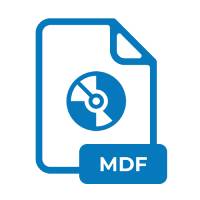.MDF File Extension

Media Disc Image File
| Developer | Alcohol Software |
| Popularity | |
| Category | Data Files |
| Format | .MDF |
| Cross Platform | Update Soon |
What is an MDF file?
The .MDF file extension represents a disc image file created using optical disc authoring software. These files essentially encapsulate the entire contents of a CD, DVD, or Blu-ray disc, including the file system, boot information, and metadata.
More Information.
Developed initially by Alcohol Soft, the .MDF file format was primarily intended for Alcohol 120%, a popular disc authoring tool used for creating virtual drives and copying optical media. Over time, other software like Daemon Tools and PowerISO also started supporting this format.
Origin Of This File.
The .MDF file format originated as part of the suite of disc image formats developed for software that needed to create, store, and manage digital representations of physical optical media.
File Structure Technical Specification.
.MDF files contain a complete binary copy of the original disc, including data, file structure, and metadata. They may also be accompanied by a .MDS file (Media Descriptor file) that includes additional information about the disc layout and properties.
How to Convert the File?
Windows:
Using PowerISO:
- Download and Install PowerISO: Get PowerISO from its official website and install it on your Windows system.
- Open PowerISO: Launch the PowerISO application.
- Select File to Convert: Click on “Tools” in the menu bar and then choose “Convert” from the dropdown.
- Choose the .MDF File: In the conversion window, select the .MDF file you want to convert.
- Select Output Format: Choose the output format (e.g., ISO) and designate the output destination.
- Start Conversion: Click “OK” to start the conversion process.
Linux:
Using AcetoneISO:
- Install AcetoneISO: Use your package manager or terminal to install AcetoneISO.
- Open AcetoneISO: Launch AcetoneISO from the applications menu or using terminal commands.
- Select Convert Option: Look for the option to convert within the interface.
- Choose .MDF File: Select the .MDF file you want to convert.
- Specify Output Format: Choose the desired output format for conversion (e.g., ISO).
- Initiate Conversion: Proceed with the conversion process by clicking the appropriate button or option.
Mac:
Using Daemon Tools for Mac or PowerISO (via Wine):
- Daemon Tools for Mac:
- Download and Install Daemon Tools: Obtain Daemon Tools for Mac from their official website and install it on your Mac.
- Open Daemon Tools: Launch the application.
- Convert .MDF File: Look for the option to convert within the interface and select the .MDF file.
- Choose Output Format: Specify the desired output format (e.g., ISO) for conversion.
- Begin Conversion: Initiate the conversion process.
- PowerISO via Wine:
- Install Wine: Download and install Wine on your Mac. Wine allows running some Windows applications on macOS.
- Install PowerISO: Install PowerISO using Wine.
- Open PowerISO: Run PowerISO through Wine.
- Follow Windows Steps: Use PowerISO’s Windows interface as described in the Windows section above to convert the .MDF file to the desired format.
Android:
Using File Converter Apps:
- Download a File Converter App: Get an Android app capable of handling file conversions, such as “File Converter” or “All File Converter.”
- Install & Open the App: Install the chosen app and open it on your Android device.
- Select the .MDF File: Locate the .MDF file you want to convert within the app.
- Choose Output Format: Select the desired output format (e.g., ISO) to convert the .MDF file.
iOS:
Using Cloud Services:
- Upload to Cloud Storage: Upload the .MDF file to a cloud storage service like Google Drive, Dropbox, or OneDrive from a computer or a compatible app on your iOS device.
- Cloud Conversion Service: Use an online cloud conversion service (such as CloudConvert) through the web browser on your iOS device.
- Select File & Output Format: Access the .MDF file in the cloud service and select the conversion format (e.g., ISO).
- Download Converted File: Once converted, download the converted file to your iOS device.
Advantages And Disadvantages.
Advantages:
- Efficient storage of disc data
- Easy creation of virtual drives for disc emulation
- Maintains original disc structure and content integrity
Disadvantages:
- Limited compatibility with native operating systems
- Larger file sizes compared to some other image formats
- Reliance on specific software for full accessibility
How to Open MDF?
Open In Windows
In Windows, .MDF files can be opened using virtual drive software like Alcohol 120%, Daemon Tools, or by converting them to more widely supported formats like ISO using programs like PowerISO or MagicISO.
Open In Linux
Linux users can access .MDF files using tools like AcetoneISO, which supports mounting and handling disc image files, including the .MDF format. Converting to compatible formats like ISO might also enable access using native tools.
Open In MAC
On Mac systems, software like Daemon Tools for Mac or using programs such as PowerISO via Wine might allow access to .MDF files. Conversion to ISO or other supported formats may also facilitate access.
Open In Android
Several Android apps, like PowerISO or WinISO, provide functionality for managing and opening .MDF files directly on Android devices. These apps typically offer the ability to mount virtual drives or convert formats for access.
Open In IOS
Accessing .MDF files on iOS devices might be challenging due to the restricted nature of the operating system. Utilizing cloud storage services with support for disc image files or using specialized apps via jailbreaking might offer limited options for access.
Open in Others
Other operating systems might require similar strategies for accessing .MDF files, primarily relying on specialized software capable of mounting virtual drives, converting formats, or utilizing third-party applications for compatibility.













